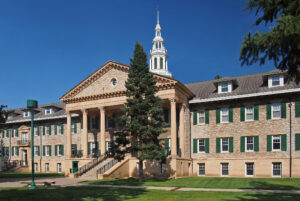 Established by the Minnesota State Legislature in 1858, the Minnesota State Academies oversees two academies which are among the oldest public schools in the state, the Minnesota State Academy for the Deaf which opened its doors in 1863, and the Minnesota State Academy for the Blind which started serving students in 1866. Both academies work together to provide a comprehensive and accessible educational environment for deaf, hard-of-hearing, deaf-blind, blind, and visually impaired students from birth through age 21. A variety of educational programs are offered throughout the year for students and families statewide.
Established by the Minnesota State Legislature in 1858, the Minnesota State Academies oversees two academies which are among the oldest public schools in the state, the Minnesota State Academy for the Deaf which opened its doors in 1863, and the Minnesota State Academy for the Blind which started serving students in 1866. Both academies work together to provide a comprehensive and accessible educational environment for deaf, hard-of-hearing, deaf-blind, blind, and visually impaired students from birth through age 21. A variety of educational programs are offered throughout the year for students and families statewide.
Prior to March 2020
We provided on-campus instructional services within the classroom; in our after school programs; and in our residential programming throughout the school year. We hosted different events for parents and families on campus, such as our monthly ASL/English read-aloud activities.
During March-June 2020
Following guidance from the Governor of Minnesota and the Minnesota Department of Education, we had two weeks to make the transition from traditional on-campus instructional services to distance learning. Our teachers, support staff, and others worked together to develop a plan of action, including supports for families, technology updates, and communication channels. We were able to deliver necessary supplies, technology, and other needs to students and their families prior to beginning our distance learning instruction in April. We also continued to provide related services such as speech/language, counseling, social work services, and so forth via distance learning and/or connecting families to local resources for support. This included meals provided by their local school districts.
How the School Rose to the Challenge
Our teachers were able to utilize Google classroom, Zoom, and other online platforms/resources to connect with families – they worked with each family to provide both general instruction and individualized support. One thing that was particularly impressive was the number of videos that our teachers developed during the duration of distance learning to support our students’ learning – according to our school policy, all videos/materials must be accessible for everyone so this required a lot of coordination to make sure each video had voice-over, captions, and ASL so that every student and their family had access. Our staff interpreters were busy throughout the spring, working on these projects alongside our teachers.
Where the School is Now
We are now gathering resources and making plans for three possible scenarios for the fall, pending more information from the governor and/or the Minnesota Department of Education. Scenario A is returning to on-campus services with modifications for health and safety, including possible modifications for individuals with health issues who might not be able to return to campus. Scenario B is a hybrid program that provides both on-campus services and distance learning, depending on different factors and statewide mandates. Lastly, Scenario C is remaining in distance learning mode, improving on services that we provided in the spring and hopefully, adding some extra services that were not allowed during the spring due to the state-wide shutdown.
Looking Ahead
We are faced with many challenges – staffing, sanitation, health&safety for students and staff, logistics, budgeting/costs, and others. We have learned a lot over the spring and hope to apply those lessons within our plans for the fall. Long term, we are looking to incorporate some additional on-line course offerings for students who are not enrolled at MSAD, utilizing techniques and strategies that we have learned through our distance learning experience.
Superintendent: Terry Wilding

